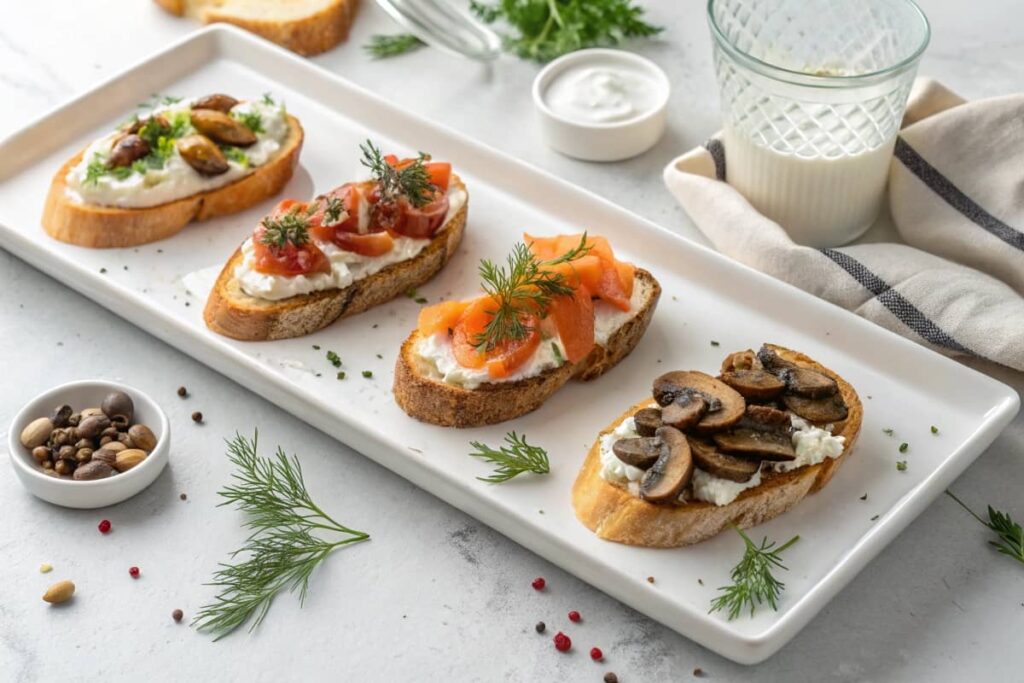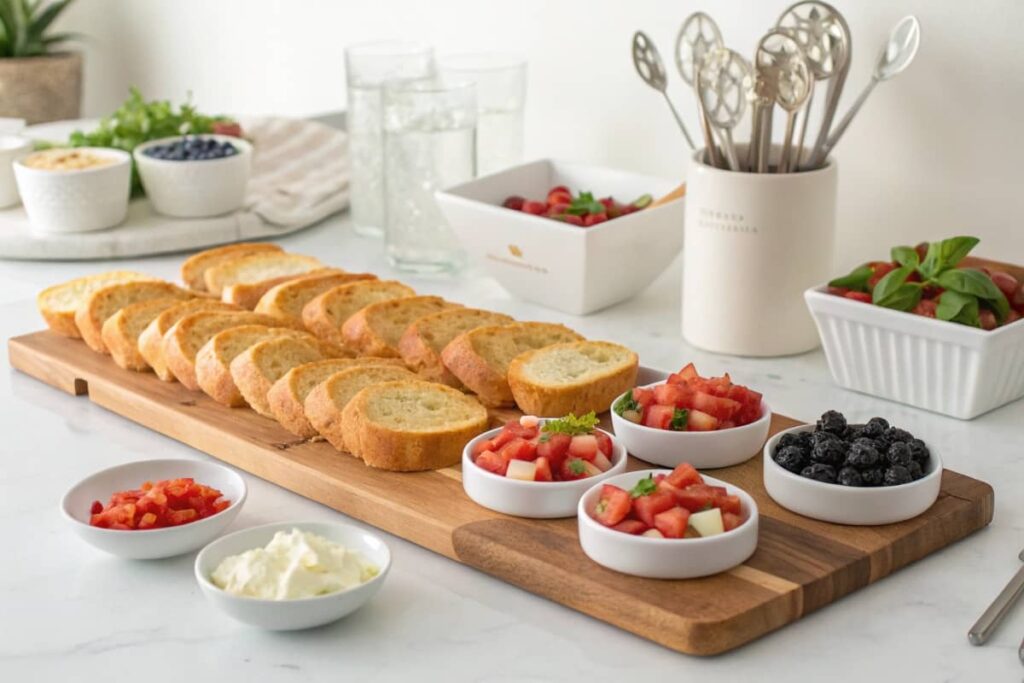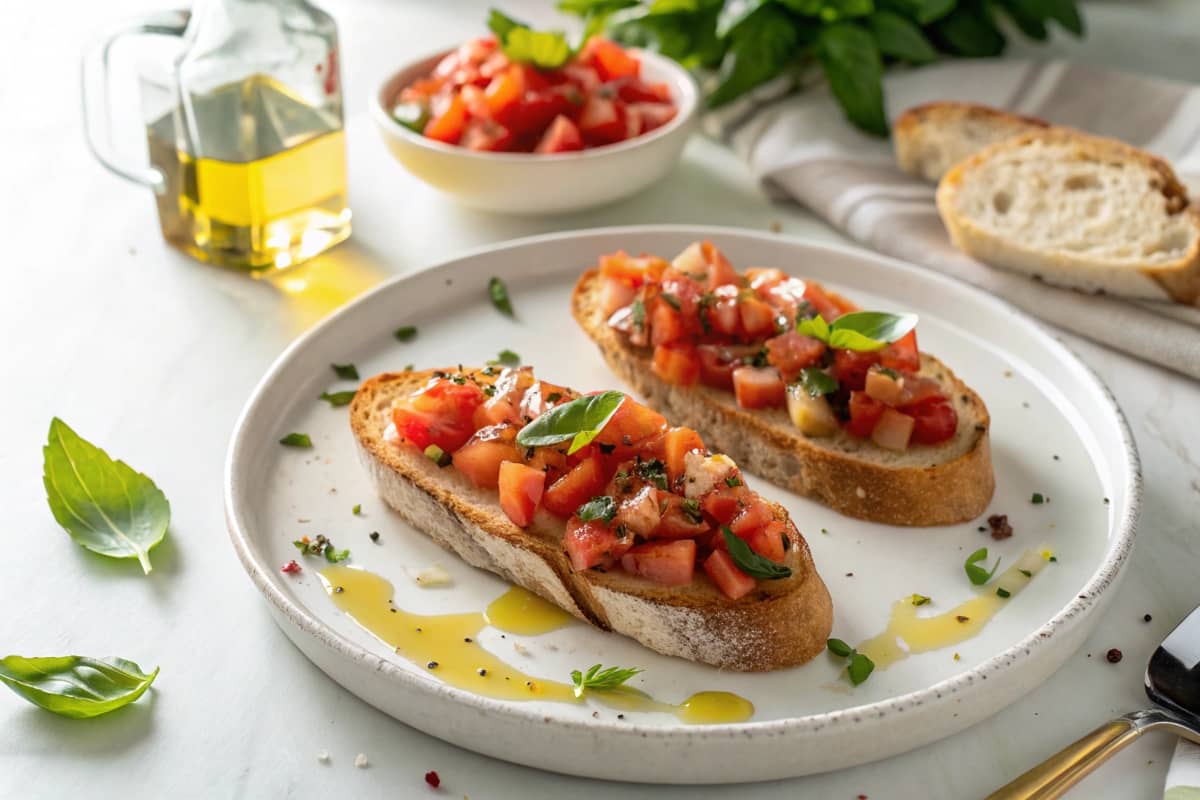You’ve probably seen crostini and bruschetta on restaurant menus or in cookbooks. Perhaps you’ve even tried both and wondered: what’s the real difference? They may look like fancy bread with toppings, but there’s more to them than meets the eye. In this article, we’ll not only dive into their origins and preparation but also explore their distinct characteristics and how to enjoy them to the fullest. Ready? Let’s get started!
Table of contents
- Introduction: Why Understanding Crostini and Bruschetta Matters
- Origins and History of Crostini and Bruschetta
- Defining Crostini: What It Is and How It’s Made
- Common Misconceptions About Crostini and Bruschetta
- Nutrition Facts: Crostini vs. Bruschetta
- Why Both Crostini and Bruschetta Deserve a Place at Your Table
- Popular Crostini Variations You Should Try
- Popular Bruschetta Variations You Should Try
- Pairing Suggestions: What to Serve with Crostini and Bruschetta
- Common Problems When Making Crostini and Bruschetta (And How to Solve Them)
- Tips for Perfect Crostini and Bruschetta Every Time
- Why Crostini and Bruschetta Are Loved Worldwide
- Nutrition Facts and Healthy Alternatives
- Why Both Crostini and Bruschetta Deserve a Place at Your Table
- How to Set Up a Crostini and Bruschetta Bar
- Tips for Serving Crostini and Bruschetta Like a Pro
- Conclusion: Embrace the Best of Both Worlds
- FAQs: Everything You Need to Know About Bruschetta
Introduction: Why Understanding Crostini and Bruschetta Matters
Imagine hosting a dinner party. You’ve got cheese, olives, and a fresh baguette waiting for the perfect topping. But should you make crostini or bruschetta? While both are popular options, understanding the difference isn’t just about impressing your foodie friends—it’s about elevating your dish. Furthermore, learning about their history and nuances can give you a new appreciation for these humble yet elegant starters.
Origins and History of Crostini and Bruschetta
To truly appreciate these appetizers, let’s first travel back in time to Italy, where they originated. Interestingly, these dishes weren’t just about flavor—they were born out of practicality and resourcefulness.
Historical Roots of Bruschetta
Bruschetta, pronounced broo-skeh-tah, has roots dating back to Ancient Rome. Farmers and olive growers often used stale bread as a base, drizzling it with freshly pressed olive oil and rubbing it with garlic. As a result, this simple snack became practical, flavorful, and satisfying—a true peasant dish showcasing the quality of Italian ingredients.
The Emergence of Crostini in Italian Cuisine
On the other hand, crostini emerged later in Tuscany. The word crostini translates to “little toasts,” which accurately describes what they are. These small, crisp bread slices were topped with pâtés, cheeses, or spreads. In comparison to bruschetta, crostini became a more refined option, often served at elegant gatherings.
Defining Crostini: What It Is and How It’s Made
Crostini embodies precision and elegance. Much like the little black dress of appetizers, it’s simple, classic, and always stylish.
Ingredients Commonly Used for Crostini
Crostini relies on high-quality ingredients. Here’s a breakdown:
- Bread: Thin slices of a baguette or similar loaf.
- Olive Oil: Used for brushing the slices before toasting.
- Toppings: Options like creamy goat cheese, savory tapenade, or even sweet fig jam.
Traditional Methods of Preparation
Making crostini may seem straightforward, but every step contributes to its perfect texture and flavor.
- Slice the Bread: Cut thin, uniform slices of baguette.
- Brush with Olive Oil: Use high-quality olive oil for the best results.
- Toast the Bread: Bake or grill until golden and crisp.
- Add Toppings: Finally, top it with sweet, savory, or a mix of both toppings.
Defining Bruschetta: What It Is and How It’s Made
Bruschetta, on the other hand, is all about rustic simplicity. Unlike crostini, it has a heartier texture and bold flavors.
Key Ingredients in Bruschetta
Here’s what you need for a classic bruschetta:
- Bread: A thick, rustic loaf like sourdough or ciabatta.
- Olive Oil: Essential for drizzling over the bread.
- Garlic: Rubbed onto the toasted bread for aromatic depth.
- Toppings: While tomatoes and basil are the most popular, other options include mushrooms, beans, or cured meats.
Traditional Techniques in Bruschetta Preparation
Making bruschetta is an enjoyable hands-on process. Moreover, it’s all about letting the ingredients shine.
- Slice the Bread: Use thick slices for a sturdy base.
- Grill or Toast: Ensure the bread has a nice char for added flavor.
- Rub with Garlic: While the bread is still warm, rub a garlic clove directly on the surface.
- Add Toppings: Finally, pile on fresh ingredients like diced tomatoes, basil, and balsamic vinegar.
Key Differences Between Crostini and Bruschetta
Now that we’ve defined them, let’s explore what truly sets Crostini and Bruschetta apart. Although they may look similar at first glance, their differences are quite significant.
Bread Type and Preparation
The type of bread is the clearest distinction. Whereas crostini uses smaller, thinner slices, bruschetta relies on thick, rustic bread. Crostini is crisp throughout, while bruschetta features a crunchy exterior with a softer, more absorbent center.
Toppings and Flavor Profiles
Crostini favors creamy or rich toppings, such as pâtés or soft cheeses. Bruschetta, by contrast, celebrates fresh, vibrant flavors like tomatoes and herbs. Simply put, crostini feels more refined, while bruschetta is rustic and hearty.
Serving Styles and Occasions
Crostini is a hit at formal events due to its elegant presentation. Bruschetta, meanwhile, feels at home in casual gatherings. For this reason, they cater to different moods and settings.
Common Misconceptions About Crostini and Bruschetta
Many people use these terms interchangeably, which can confuse them. In reality, they are distinct dishes with their own preparation methods and presentation styles.
Are They Interchangeable?
Not really. Although they share similarities, their bread types, textures, and toppings set them apart.
Mislabeling in Restaurants and Menus
Interestingly, restaurants often mislabel any bread-based appetizer as bruschetta. To avoid this confusion, it helps to know the key differences yourself.
Nutrition Facts: Crostini vs. Bruschetta
Let’s take a closer look at the nutritional differences. Although both are light, bruschetta tends to have more calories due to the thicker bread and toppings.
Crostini (per serving):
- Calories: ~80
- Carbs: 12g
- Fat: 3g
- Protein: 2g
Bruschetta (per serving):
- Calories: ~120
- Carbs: 18g
- Fat: 5g
- Protein: 3g
For healthier options, you can use whole-grain bread, reduce the olive oil, or add more vegetables to the toppings.
Why Both Crostini and Bruschetta Deserve a Place at Your Table
Crostini and bruschetta each bring something special to the table. Crostini is perfect for showcasing luxurious toppings, while bruschetta lets simple, fresh ingredients shine. Why not enjoy the best of both worlds?
Popular Crostini Variations You Should Try
Crostini is like a blank canvas—it’s versatile and perfect for experimenting with flavors. Here are some popular variations to inspire your next appetizer platter.

Savory Crostini Recipes
- Goat Cheese and Honey: Creamy goat cheese paired with a drizzle of honey and a sprinkle of crushed walnuts is a crowd-pleaser.
- Smoked Salmon and Dill: A touch of cream cheese, a slice of smoked salmon, and fresh dill make for an elegant bite.
- Mushroom and Thyme: Sautéed mushrooms with garlic and thyme atop crispy crostini bring earthy and comforting flavors to life.
Sweet Crostini Recipes
- Fig Jam and Brie: Spread a dollop of fig jam over toasted crostini, then top with a thin slice of brie for a sweet and savory combo.
- Ricotta and Fresh Berries: Creamy ricotta with fresh blueberries or raspberries is as refreshing as it gets.
- Nutella and Strawberries: For a dessert crostini, spread Nutella and add sliced strawberries for a decadent treat.
Popular Bruschetta Variations You Should Try
Bruschetta goes beyond the classic tomato-and-basil combination. Here are some delicious ways to mix things up.
Classic Tomato and Basil Bruschetta
This timeless favorite never fails to impress. All you need is diced tomatoes, fresh basil, minced garlic, a splash of olive oil, and a hint of balsamic vinegar. Spoon it onto grilled bread, and you’ve got magic in a bite.
Creative and Modern Bruschetta Ideas
- Avocado Bruschetta: Think of it as avocado toast with an Italian twist. Mash ripe avocado and layer it on grilled bread with cherry tomatoes and a squeeze of lemon.
- Prosciutto and Melon Bruschetta: Sweet melon and salty prosciutto create a balanced, gourmet appetizer.
- White Bean and Rosemary Bruschetta: Mash white beans with olive oil, garlic, and rosemary for a hearty, savory topping.
Pairing Suggestions: What to Serve with Crostini and Bruschetta
While these appetizers are delicious on their own, pairing them with the right sides takes them to the next level.
Other Complementary Dishes
- Salads: A fresh green salad with vinaigrette balances the richness of crostini and bruschetta.
- Soups: Serve alongside a bowl of tomato basil soup or creamy mushroom soup for a comforting combination.
- Charcuterie Board: Pair these appetizers with cheeses, cured meats, and olives for a complete spread.
- Fresh Juices or Sparkling Water: For beverages, options like sparkling water infused with lemon or fresh fruit juice add a refreshing touch.
Common Problems When Making Crostini and Bruschetta (And How to Solve Them)
Let’s face it, making appetizers can sometimes lead to mishaps. Here are some common issues and how to avoid them.
Bread Getting Too Soggy
- Problem: The toppings make the bread mushy, especially if left sitting too long.
- Solution: Brush the bread with olive oil before toasting to create a protective barrier. Add toppings right before serving.
Toppings Falling Off
- Problem: It’s hard to keep toppings in place, especially chunky ones.
- Solution: Use a slightly sticky base like cream cheese or ricotta to hold the toppings in place. Don’t over-pile your bread!
Balancing Flavors
- Problem: Too salty, too bland, or just plain overwhelming.
- Solution: Taste as you go and aim for balance. If your toppings are salty, add a touch of sweetness or acidity to even things out.
Tips for Perfect Crostini and Bruschetta Every Time
Want to nail these appetizers every time? Follow these tips.
Selecting the Right Bread
The bread makes or breaks your crostini or bruschetta. Choose a baguette for crostini and a hearty loaf like sourdough for bruschetta. Always ensure the bread is fresh.
Using High-Quality Ingredients
Since these appetizers are so simple, every ingredient matters. Opt for extra virgin olive oil, fresh herbs, and ripe produce. Trust me, you’ll taste the difference.
Why Crostini and Bruschetta Are Loved Worldwide
Crostini and bruschetta have evolved from their humble Italian origins into globally celebrated appetizers. But what makes them so universally appealing? The answer lies in their adaptability. Whether you prefer rich, creamy toppings or fresh, zesty flavors, there’s a crostini or bruschetta variation for every palate.
These dishes are also perfect for entertaining. They’re easy to prepare in advance, visually appealing, and endlessly customizable. Hosting a party? A platter of crostini and bruschetta instantly adds a touch of sophistication.
Nutrition Facts and Healthy Alternatives
Crostini and bruschetta are naturally light appetizers, but their nutritional value can vary based on the ingredients. Here’s how they stack up and some tips to make them healthier without compromising taste.
Nutritional Overview
Crostini (per serving):
- Calories: ~80
- Carbohydrates: 12g
- Fat: 3g
- Protein: 2g
Bruschetta (per serving):
- Calories: ~120
- Carbohydrates: 18g
- Fat: 5g
- Protein: 3g
Making Healthier Choices
- Use Whole-Grain Bread: Swap white bread for whole-grain options to add fiber and nutrients.
- Cut Back on Oil: Use a light spray of olive oil instead of brushing liberally.
- Add More Veggies: Load up on colorful, fresh vegetables for extra vitamins and minerals.
- Choose Lean Proteins: If adding meats, opt for lean cuts like turkey slices or grilled chicken.
Why Both Crostini and Bruschetta Deserve a Place at Your Table
It’s hard to choose between crostini and bruschetta, and honestly, you don’t have to! Each has its unique charm and culinary role. Crostini, with its delicate crunch, is perfect for elegant events where guests might enjoy more intricate toppings. Bruschetta, with its rustic appeal, feels right at home in casual settings, offering bold flavors that satisfy.
Both appetizers are fantastic vehicles for showcasing high-quality ingredients, from fresh produce to artisanal cheeses. The beauty of these dishes lies in their simplicity—when done right, they transform everyday ingredients into something extraordinary.
How to Set Up a Crostini and Bruschetta Bar

If you’re hosting a gathering, why not create a crostini and bruschetta bar? It’s interactive, and fun, and allows guests to customize their appetizers. Here’s how to do it:
Prepare the Bases
- Toast a mix of baguette slices for crostini and thick, rustic bread slices for bruschetta.
- Keep the bread warm by wrapping it in a clean kitchen towel or storing it in a warming tray.
Offer a Variety of Toppings
Savory Options:
- Tomato and basil mix
- Sautéed mushrooms
- Olive tapenade
- Ricotta with fresh herbs
Sweet Options:
- Honey and figs
- Nut butter with sliced bananas
- Cream cheese with a berry compote
Add a DIY Element
Provide small bowls of toppings, utensils, and serving plates so guests can create their combinations. Label each topping for clarity.
Tips for Serving Crostini and Bruschetta Like a Pro
Making and serving these appetizers is an art, but with a few tricks, you can wow your guests.
Timing Is Everything
Prepare your bread and toppings in advance, but don’t assemble until just before serving to keep the bread crisp.
Presentation Matters
Use a large wooden board or a clean slate platter to arrange your crostini and bruschetta. Garnish with fresh herbs for an extra pop of color.
Don’t Forget Dietary Preferences
Include a variety of toppings, including vegetarian, vegan, and gluten-free options, to ensure all your guests are satisfied.
Conclusion: Embrace the Best of Both Worlds
Crostini and bruschetta aren’t just appetizers—they’re a celebration of Italian tradition. By appreciating their differences, you can make the most of these versatile dishes.
So, why choose one when you can enjoy both? With a little creativity, you can create a platter that’s not only delicious but also a true crowd-pleaser.
FAQs: Everything You Need to Know About Bruschetta
What goes best with bruschetta?
Bruschetta pairs beautifully with a variety of dishes and sides. Since it’s a flavorful appetizer, it works well with lighter fare like fresh salads or vegetable platters. Here are some pairing ideas:
- Salads: A crisp green salad or a tangy arugula salad with lemon vinaigrette complements bruschetta’s bold flavors.
- Cheese Platters: Serve alongside fresh mozzarella, Parmesan, or burrata for a creamy contrast.
- Soups: Tomato-based soups like minestrone or tomato bisque make for a comforting combination.
- Grilled Vegetables: Roasted zucchini, bell peppers, or eggplant provide a hearty yet healthy pairing.
What is bruschetta best served with?
Bruschetta is versatile and can be served as an appetizer, side dish, or even a light meal. Italians often pair it with:
- Antipasto Platters: Featuring cured meats, olives, and marinated artichokes for a complete starter.
- Main Courses: It works well as a side for grilled chicken, seafood, or pasta dishes.
- Beverages: For non-alcoholic options, pair bruschetta with sparkling water infused with lemon or a refreshing iced tea.
What’s the difference between bruschetta and caprese?
While both dishes feature fresh tomatoes, basil, and mozzarella, they are distinct in preparation and presentation:
- Bruschetta: Focuses on grilled or toasted bread as the base, topped with tomato, basil, garlic, and olive oil. It’s bread-forward and emphasizes crunchy textures.
- Caprese: A salad that layers sliced tomatoes, fresh mozzarella, and basil, often drizzled with olive oil and balsamic glaze. There’s no bread involved, making it lighter and more focused on the ingredients themselves.
Think of bruschetta as a hearty, handheld snack, while caprese is a fork-and-knife dish.
